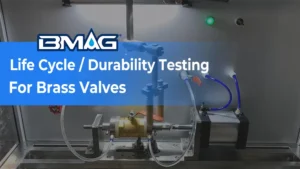திரவக் கட்டுப்பாட்டு அமைப்புகளின் உலகில் - HVAC மற்றும் இரசாயன செயலாக்கம் முதல் நீர் சுத்திகரிப்பு வரை - ஒரு வால்வின் சரியான தேர்வு மிக முக்கியமானது. But how does one scientifically choose the right-sized valve to ensure a system operates with stability, efficiency, and precision? The answer lies in a fundamental parameter: theசி.வி.-Flow Coefficient and கே.வி.-Flow Factor.
The Flow Coefficient is the universal language for quantifying a valve’s capacity to pass fluid. It primarily comes in two forms: கே.வி. (used in the metric system) மற்றும்சி.வி. (used in the imperial system). Understanding their definitions, calculation methods, and relationship is an essential skill for every engineer and technician.
உள்ளடக்க அட்டவணை
மாற்று1. Demystifying the Kv Value (Flow Factor)
What is the Kv Value?
The Kv value is the flow coefficient standard widely used in Europe and regions that adhere to IEC standards. Its definition is highly specific:
Definition: The Kv value is the flow rate of water incubic meters per hour (m³/h) that will pass through a valve with a pressure drop of1 பட்டி across it, at a water temperature between 5-30°C.
In simple terms, Kv is a direct measure of a valve’s flow capacity under standardized conditions.A higher Kv value signifies a greater flow capacity. This standardized measurement, often based on norms like DIN EN 60534, allows for a fair and accurate comparison of different valves.
The Kv Calculation Formula
For real-world engineering applications, a more versatile formula is required to calculate the necessary Kv for any given operational conditions.

- General Formula for Liquids:Kv = Q * √(SG / ΔP)
- Simplified Formula for Water (Most Common):
Since the Specific Gravity (SG) of water is 1, the formula simplifies to:Kv = Q / √ΔP
கே.வி. Formula Parameters:
- கே.வி.: The flow coefficient you need to calculate.
- Q: The required fluidஓட்ட விகிதம் through the valve, in units ofm³/h.
- ΔP: திpressure drop across the valve (P_inlet – P_outlet), in units ofபட்டி.
- SG: திSpecific Gravity of the fluid (the ratio of the fluid’s density to the density of water).
2. Understanding the Cv Value (ஓட்டம் குணகம்)
What is the Cv Value?
The Cv value is the flow coefficient used in North America (primarily the United States). It is the conceptual equivalent of Kv, but based on the imperial unit system.
Definition: The Cv value is the flow rate of water inU.S. Gallons Per Minute (GPM) that will pass through a valve with a pressure drop of1 pound per square inch (psi) across it, at a water temperature of 60°F.
The Cv Calculation Formula
Like Kv, Cv has a corresponding formula for practical calculations.

- General Formula for Liquids:Cv = Q * √(SG / ΔP)
- Simplified Formula for Water:Cv = Q / √ΔP
Important! While the formula’s structure is identical to Kv’s, theunits are completely different:
- சி.வி.: The flow coefficient.
- Q: The flow rate, in units ofUS GPM.
- ΔP: The pressure drop, in units ofpsi.
- SG: The Specific Gravity of the fluid (water = 1).
3. Kv vs. சி.வி.: Key Differences and Conversion
While both Kv and Cv describe a valve’s capacity, their numerical values differ due to their reliance on different unit systems.
Kv vs. சி.வி. Summary of Core Differences:
| Feature | Kv Value | Cv Value |
| Unit System | Metric | Imperial |
| Media Temp. | 5 – 30°C | 60°F |
| Flow Unit | m³/h | US GPM |
| Pressure Unit | பட்டி | psi |
Kv to Cv Conversion Formulas
For any given valve, the relationship between its Kv and Cv values is fixed:
Cv = 1.156 × Kv
Kv = 0.865 × Cv
Example Conversion:
Imagine you have a product datasheet from the U.S. that specifies a valve’sCv = 50. To use this in a metric system design, you would calculate its Kv value:
- Calculation:
Kv = 0.865 × 50 = 43.25 - முடிவு:
This valve has a Kv value of approximately43.25.
4. The Kvs Value: A Valve’s Maximum Potential
What is the Kvs Value?
In valve specification sheets, you will frequently encounter the termKvs.
திKvs value is the specific Kv value of a valve when it is in the100% fully open position. It represents the valve’s maximum possible flow capacity and is a fundamental characteristic determined by its physical design.
Manufacturers test and certify the Kvs value for each valve model and size.
Does a “Cvs” Value Exist?
While conceptually identical, there isno widely used, dedicated term like “Cvs” in the industry. Instead, when a valve’s “சி.வி.” is mentioned without specifying an opening percentage, it is universally understood to mean itsCv value at the fully open position. This is also referred to as theRated Cv orMaximum Cv.
5. The Core Purpose of Kv: Scientific Valve Sizing
The ultimate goal of calculating Kv is toscientifically select the correct valve size. This process involves two steps:
- Calculate therequired Kv based on the system’s desired flow rate (Q) and acceptable pressure drop (ΔP).
- Select a valve product whoserated Kvs is appropriate for the calculated required Kv.
The Golden Rule of Valve Sizing by Kv: தி 20-80% Range
For stable and precise flow control, the industry strongly recommends the following principle:
The calculated required Kv should fall between 20% மற்றும் 80% of the selected valve’s fully open Kvs rating.
This range is known as the valve’soptimal control zone.
- Why not below 20%? (Oversized Valve)
If the required Kv is a small fraction of the valve’s Kvs, the valve only needs to open slightly (e.g., 5%) to meet the demand. This makes the system extremely sensitive; a tiny movement of the actuator causes a large change in flow, leading to control instability, “hunting” (oscillation), and rapid wear on the valve’s internals. It’s like trying to parallel park a supercar—the slightest touch of the accelerator makes it lurch. - Why not above 80%? (Undersized Valve)
If the required Kv is very close to the valve’s Kvs, the valve will be nearly wide open during normal operation. When the system requires a peak flow, the valve has no additional capacity (headroom) to provide it. It loses its ability to “modulate” and effectively becomes an on/off switch, losing all control authority. It’s like driving a small car with the pedal to the floor on a highway—there’s no power left to accelerate and overtake.
6. Kv’s Importance Across Different Valve Types
The importance of Kv varies depending on whether a valve’s primary function ismodulating control or simpleon/off isolation.
①. Control Valves: Kv is the Key Parameter
For modulating valves, the concept of Kv is the very core of their design and selection.
- Applicable Valves: குளோப் வால்வுகள், Balancing Valves, Regulating Valves.
- Why Kv is Critical:
- Kv for Sizing: தி 20-80% rule is mandatory. Selecting the wrong Kvs means the entire control loop will fail.
- Flow Characteristic Curve (Kv vs. Travel): This curve defines the valve’s control quality. Alinear curve is good for steady pressure drops, while anequal percentage curve is ideal for systems with variable pressure drops, providing fine control at low openings and coarse control at high openings.

Image source: control.com
②. On/Off (Isolation) Valves: Kvs is a Measure of Efficiency
For valves used only to open or close a line, the goal is different.
- Applicable Valves: பந்து வால்வுகள், கேட் வால்வுகள், Plug Valves.
- Why Kvs is a Key Performance Indicator: The objective is to have theleast possible obstruction when open. Ahigher Kvs value means lower flow resistance, which translates directly to alower pressure drop (ΔP). This ensures that the downstream piping receives its required flow rate to maintain production while simultaneously reducing energy waste.
7. Practical Applications: Where Kv is Mission-Critical
Calculating Kv is non-negotiable in any industry or system that requires precise fluid modulation.
- HVAC & Building Automation: Essential for controlling hot/chilled water flow to coils (AHUs, FCUs) to ensure occupant comfort and maximize energy efficiency.
- Process Industries (Chemical, Petrochemical): Critical for controlling reactant feeds, temperature control loops, and pH neutralization, where precision directly impacts product quality and safety.
- நீர் & Wastewater Treatment: Necessary for accurate chemical dosing (e.g., flocculants, disinfectants) and controlling airflow in aeration basins to optimize treatment effectiveness and minimize operational costs.
- Food, Beverage & Pharmaceutical: Guarantees batch consistency and product quality by precisely controlling ingredient mixing, fermentation temperatures, and Clean-in-Place (CIP) processes.
முடிவு
Mastering Kv and Cv values meaning, calculation, and—most importantly—the “20-80%” sizing rule is the key to designing and operating fluid control systems that are stable, efficient, and reliable. The next time you see a Kvs or Cv value on a datasheet, you will know exactly what it means and how to use it to make the right engineering decision.
From Theory to Application: Finding Your Solution
Now that you’re equipped with a detailed understanding of Kv and Cv values, the next step is putting that knowledge into practice. When it comes to sourcing valves for your critical systems—especially for bulk procurement or large-scale projects—partnering with an expert is key.
BMAG’s team of fluid control specialists is ready to help. Whether you need to optimize an existing system or design a new one from the ground up, we combine deep application knowledge with an extensive inventory to ensure you get the right valve, every time.






